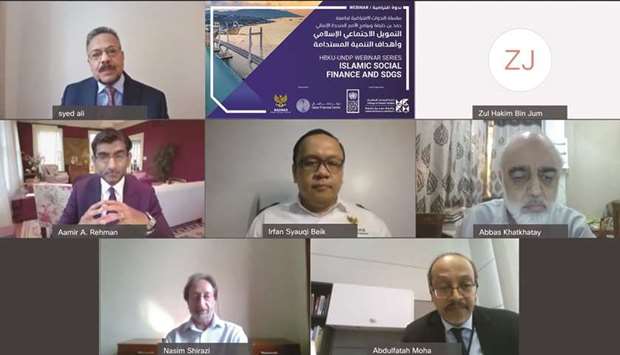The potential for Zakat financing to fill funding gaps for achieving the Sustainable Development Goals (SDGs) was the opening subject of a three-part webinar series co-organised by the College of Islamic Studies (CIS) at Hamad Bin Khalifa University (HBKU) and the United Nations Development Programme (UNDP), in partnership with Qatar Financial Centre (QFC) Authority.
The first instalment of the HBKU-UNDP Webinar Series: Islamic Social Finance and SDGs on October 6 showcased National Zakat Board Indonesia’s (BASNAZ) innovative application of Zakat funds for local SDG projects in underserved communities. Consideration was also given to how the BAZNAS Zakat Model for development can be replicated and utilised within and beyond the Islamic world. In keeping with all HBKU events, proceedings concluded with opportunities for audience members to pitch questions and respond to observations made by the panellists.
Part one of the HBKU-UNDP Webinar Series was moderated by Dr Aamir Rehman, a senior adviser to the UNDP and consultant to the World Bank. A case study of Indonesia’s use of Zakat funds at the local level was provided by Dr Irfan Syauqi Beik, director of Zakat Distribution and Utilisation, BAZNAS. Participants gained additional insights from Dr Nasim Shirazi, professor of Islamic Finance and Economics at CIS; Dr Abdulfatah Mohamed, visiting assistant professor of Public Policy at CIS and Dr Mohamed Abbas, Khatkhatay, founder of Mesco in India.
Dr Syed Nazim Ali, director of CIS’ Research Division and its Centre of Islamic Economics and Finance, said: “The webinar not only reflects HBKU’s determination to help fulfil the SDGs, but also CIS’ place at the forefront of global and intellectual debates on the applied nature of Islamic Studies. Innovative and resourceful use of Islamic social finance will be crucial over the years ahead, particularly when it comes to sustainability issues. We’re confident that this and our other webinars will provide an informed overview of what relevant types of Islamic social financing look like.”

Participants at the webinar.


